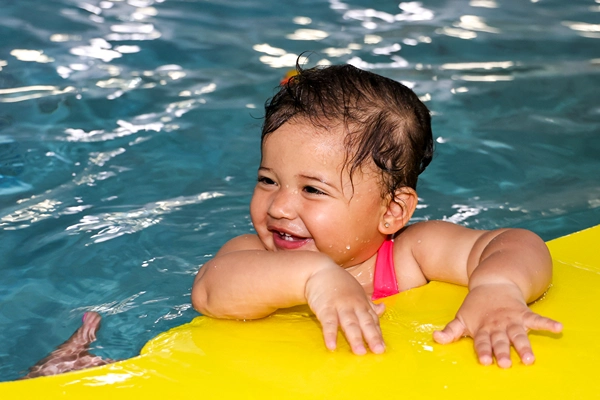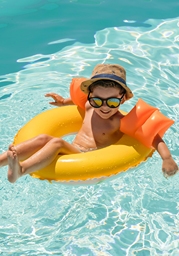Are Floaties Safe for Kids?
Many children want to learn to swim. Sometimes, they need a little extra encouragement or a greater sense of security to acquire the confidence to swim. Parents often try to make their children swim with floaties first. Although floaties can make them feel more secure in water, there are safety implications that parents should know about.
As you’ll learn in swim school, you may encounter various opinions on the use of floaties and their effectiveness, but here is what you should keep in mind to make an informed decision:
Understanding Floaties & Safety Concerns
Floaties are colorful inflatable devices worn on the arms or around the waist that can help you stay afloat. These devices are cute and come in varying sizes, providing a sense of security to the swimmer.
However, they are not a substitute for proper swim instruction or supervision. Swimmers can still make dangerous mistakes even while wearing floaties. The safety concerns around floaties are not necessarily the devices themselves but the child’s overall behavior while using them. Here are some plausible scenarios that make floaties risky:
False Sense of Security
The main concern surrounding floaties is that they often create a false sense of security for children and their parents.
Picture this: your child starts believing they can swim independently because they have floaties. This confidence might make them take unnecessary risks, such as venturing further into deeper water without adequate skills.
Depending on where the child is swimming, waves or currents can make the situation dangerous. The child might even take off their floaties, thinking they can manage without them.
Inadequate Supervision
Some parents rely too heavily on floaties, believing it means their child is always safe. This cannot be further from the truth. Children must always be supervised in the water whether they are using floaties or not.
Accidents can occur at any time. In the water, they happen fast. Floaties do not guarantee safety in the water and using them does not mean that you should relax and believe your child is safe.
Potential for Deflation or Damage
All floaties can deflate easily or get damaged with rough use or exposure to sharp objects. Maybe your child has a bracelet or sharp toy that punctures their floaties.
If the floaties fail and the child is in the water, they can panic, leading to a dangerous situation. Panic is the main contributor to drowning accidents.

Swim Lessons Are Key
The best way for children to remain safe in the water is by taking proper swimming lessons. Kids learn in swim school to not only use swimming devices but also to swim on their own. They will learn essential skills such as floating, treading water, and other swimming techniques.
Floating, for example, is a crucial skill in swimming since it allows you to rest when you are too tired to swim. Learning various swimming techniques is crucial to understanding how to navigate the water in different circumstances and stay safe.
These lessons are invaluable for building confidence and ensuring that children can handle themselves in various water situations that would otherwise be deadly. For example, when facing big waves that break before they hit you, you should never attempt to jump them.
The force of the wave is so powerful it will spin and drag you underwater. When you resurface, you’ll be too tired to swim and another wave will come to tire you out further. Instead, the best thing to do is to know how to swim underwater and hold your breath. Go beneath the wave and avoid its primary force. This and other valuable lessons can be taught in swimming schools to children of various ages. These skills and knowledge will be applicable throughout their lives.
Alternatives to Floaties
If you are a parent who still wants to rely on floaties, always make sure that your child does not have something sharp with them with which they can potentially deflate the floaties. Always keep a watchful eye on them and do not let them get too far away from you. Ensure that the floaties are fit for their age and size and are properly inflated before use.
If you don’t want to use floaties, consider other flotation devices. Some other devices can be safer, such as:
U.S Coast Guard-Approved Life Jackets
U.S. Coast Guard-approved life jackets provide safety in various water conditions. They are far superior to floaties as they provide more reliable buoyancy. Look for the label and approval number to check if the life jacket is approved.
It’s usually inside the vest and it indicates that the jacket has been tested for performance. Children’s life jackets come in various sizes indicating the floating weight. They can be harnessed so that even if the child swims aggressively or there are waves present, the jacket will generally stay in place and keep them safe. The adjustable belts will ensure that your child is tightly secure and comfortable.
Swim Belts
Swim belts are an excellent device for children who want more freedom in the water. These devices help with buoyancy and can be used to teach proper swimming techniques and form. Although they can still come off, their main purpose is to teach children to swim rather than just stay afloat.
Whether you want to buy floaties for your children or use other devices, keep in mind that they always must be supervised when they are in the water since no device can guarantee absolute safety. Consider taking your children to swimming classes and letting them develop the necessary skills to enjoy this activity and get some peace of mind while they’re in the water.




